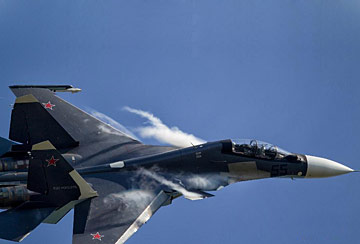 China's new-type guided missile frigate 'Bengbu' in live fire training
China's new-type guided missile frigate 'Bengbu' in live fire training
 China’s weekly story (2013.8.10 - 8.23)
China’s weekly story (2013.8.10 - 8.23)
 Flight team performs first show abroad
Flight team performs first show abroad
 With parents bedridden, 12-year-old boy becomes pillar of the family
With parents bedridden, 12-year-old boy becomes pillar of the family
 Top 10 private Chinese enterprises 2013
Top 10 private Chinese enterprises 2013
 The most gorgeous Chinese women in the eyes of foreigners
The most gorgeous Chinese women in the eyes of foreigners
Combat imposes high demands on the UCAV's flight control system. Whether in aerial combat or an attack on an enemy target, both the UCAV itself and the target can be moving at high speeds. The flight control system must be able to control the aerial maneuvers of the UCAV in response to a dynamic battlefield environment.
Returning to and landing on the aircraft carrier are the steps with the highest accident rate for both manned and unmanned combat aircraft. Therefore, China’s shipborne UCAV will require not only advanced satellite navigation, but also a higher specification of flight control system to achieve a safe landing.
The third element is intelligent attack-defense integrated firing control. The U.S. military classifies UAVs in levels ranging from ACL-1 to ACL-10 (totally autonomous). A relatively complete firing control system begins at level ACL-4. The more advanced generation of shipborne UCAVs such as the X-47B are classified at level ACL-6, that is a UAV with the capacity to deal with sudden threats and targets in the form of multiple drones. At this level, the shipborne UCAV is required to have an autonomous attack-defense integrated firing control system with a significant degree of “intelligence”.
The fourth feature is a high thrust-weight ratio turbofan, achieved at low cost. The turbojet/turbofan engines used on American UCAVs are always derived from civil engines or manned military planes. For example, the X-47B uses the F100-220U turbofan engine derived from the F-100, originally developed for the F-16. The characteristics and combat environment for a UCAV require that its engine should have a low fuel consumption rate, a high thrust-weight ratio, low R&D and purchase costs, convenience for maintenance, and fitness for long-term storage.


 Mexican president delivers first State of Nation address
Mexican president delivers first State of Nation address Highlights of MAKS 2013 Int'l Aviation and Space Show
Highlights of MAKS 2013 Int'l Aviation and Space Show  10th China-ASEAN Expo opens in Nanning
10th China-ASEAN Expo opens in Nanning Baby born to save his sister - the story of a savior sibling
Baby born to save his sister - the story of a savior sibling Lady of mystery: Female SWAT team in prison disclosed
Lady of mystery: Female SWAT team in prison disclosed  Single mother, baby live in KFC restaurant for months
Single mother, baby live in KFC restaurant for months Top 10 naked hotels in the world
Top 10 naked hotels in the world The most gorgeous Chinese women in the eyes of foreigners
The most gorgeous Chinese women in the eyes of foreigners A collection of bizarre rooftop buildings around China
A collection of bizarre rooftop buildings around China Putin intimate contacts with marine animals
Putin intimate contacts with marine animals China's frigate 'Bengbu'in fire training
China's frigate 'Bengbu'in fire training Fresh students 'forced' to register in university independently
Fresh students 'forced' to register in university independently 2013 Taiwan Int'l Tourism Expo kicks off in Taipei
2013 Taiwan Int'l Tourism Expo kicks off in Taipei Photo story: Take a gap year
Photo story: Take a gap year Nokia's Global Headquarters: visiting a declining empire
Nokia's Global Headquarters: visiting a declining empireDay|Week|Month